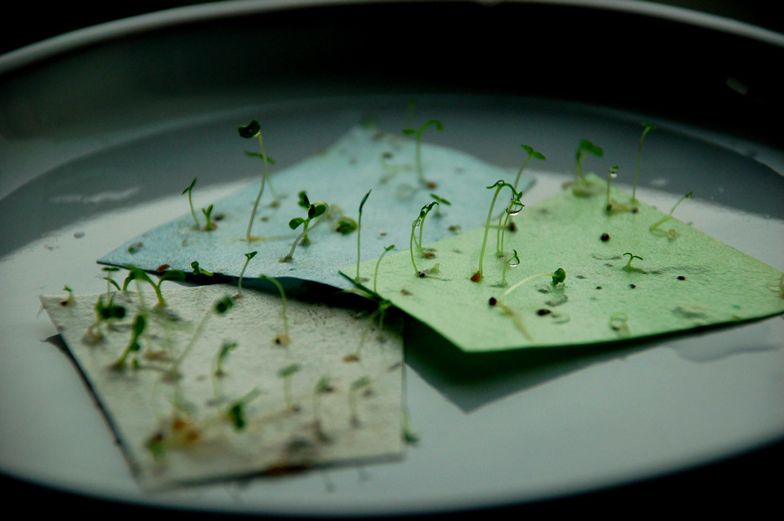
Seed paper is a type of paper that has embedded seeds. The seeds will germinate when the paper is planted in the soil. Growing your own plants and flowers is an excellent way to put seed paper to use. Seed paper can be used to make cards, invitations, and other paper crafts.
To put it simply, seed paper is paper that includes seeds. They are one-of-a-kind and are also known as plantable seed paper. It is a form of seeded paper. Their thickness, seeds, and materials used can differ according to the industry.
A fresh uprising against deforestation. The Plantable Packaging meta trend includes seed paper. 54% of US consumers feel sustainable packaging is important in their shopping decisions, and plantable packaging is becoming a viable alternative, thanks to an increasing number of companies offering plantable packaging solutions on an enterprise level. This document provides solutions to all immoral practices against nature. Thus, interest in seed paper is growing as businesses begin to employ the material to make eco-friendly, plantable packaging for their products.
Production Process
Here are production methods in three clear processes and their impact on the environment.
- Handmade Seed Paper
100% recycled paper is used to make handmade seed paper. This sort of paper can take the shape of a newspaper, printing paper, or marketing materials that do not include a lamination layer.
Any suitable paper will be blended with seeds and divided into molds and deckles. The pulp is then flattened to reach the necessary thickness or GSM of each sheet. It will then be set out to dry using a combination of sun and drainage from the mold and deckle’s sieve.
The primary environmental issue when creating this paper is the use of water. To make a proper pulp, the recycled paper must be blended with a large volume of fresh, clean water. While some water will be reused, a significant amount of moisture will be lost during the drying process, negatively impacting the environment. Despite this water waste, handmade seed paper is unquestionably the most environmentally beneficial way of production.
- FSC Certified Seed Paper
Unlike handmade paper, FSC-certified seed paper is created from pulp from virgin trees. It is worth mentioning that these FSC-certified logging practices are less sustainable than utilizing 100% recycled paper.
Cutting down trees is a need in today’s world; but, ensuring that you do so in an ethical and sustainable manner is your personal responsibility.
- Cotton Seed Paper
Some seed paper is made by combining cotton fibres with wood pulp or recycled paper. Cotton paper, in our experience, has fibres that can inhibit germination, so it is a type of paper we avoid.
Cotton seed paper has a wide range of environmental impacts. Manufacturers can choose to employ old clothes and materials, which is a more environmentally responsible choice but requires material procurement.
Some manufacturers are known to use virgin cotton in their plantable paper. Cotton production is not especially environmentally friendly. To make space for vast commercial cotton farms, large swaths of wild areas and habitats are frequently removed.
Benefits of Seed Paper
Every tree that has been felled makes the earth cry. It is past time for us to assume full responsibility for the protection of our mother planet. Seed paper is 100% sustainable, handmade, recycled, and upcycled. It is even cruelty-free on Earth, which may sound strange to some people but is entirely legitimate. People have been cruel and brutal to our planet, and with this interesting seed paper, we may ensure that the earth regains its faith in kindness.
It is the best alternative for any single-use paper, such as gift tags and present wrap. They are the ideal match for those who care about the environment. The texture of seed paper is ideal for writing, drawing, painting, and printing.
As if that wasn’t enough, plantable seed paper can be coloured with water-based organic colors. As a result, you can be certain of receiving a high-quality product that is also environmentally friendly.
It’s perfect for wedding invitations and cards. Greeting cards and single-use coasters are more alternatives. We can reduce waste by planting seed paper and watching it grow into fewer plants if we utilize seed paper. The little seeds embedded in the paper elevates it even further.
How is Seed paper Eco-Friendly?
Seed paper is manufactured from paper that has not been harvested from trees. Tree-free paper is created from mulberry, cotton rags, bananas, and corn husk, and is very environmentally beneficial. Because the paper is chemical-free, the seeds last a long time. Our paper breaks down quickly in the soil, allowing the seeds to sprout. As a result, seed paper is an excellent example of eco-friendliness and sustainability.
How Does Seed Paper Work?
Growing paper is designed in such a manner that when it is placed in soil, the paper composts and the seeds begin to germinate. Of course, we want to accomplish this, but how do you secure the greatest possible results? So, here’s a step-by-step instruction to turning your hands green on the spur of the moment.
Prepare
First, fill a container halfway with excellent potting soil. Tamp the soil down and add more if necessary. You want the pot to be filled but not overflowing. You can plant the paper indoors or outside, depending on the temperature and conditions at the time of planting.
Plant
Take your seed paper and wrap it around the soil in the prepared pot. It is acceptable if the paper overlaps. Make sure to soak the paper. Spread a 1/8-inch layer of soil over the plantable paper pieces and gently push it down.
Water
After you’ve planted the paper in your container, soak it thoroughly. You want the paper and soil to be properly damp but not swimming in water. Keep the paper moist at all times throughout the first 10 days. Water is required for germination because the seeds must first properly separate from the paper and die before sprouting. A bright spot around your house will undoubtedly assist your plant to thrive.
Growth
Keep the paper moist until the sprouts appear. The plant must soak up water and sunlight before it may grow properly. Overwatering will kill the plant.
Enjoy
When the flowers begin to sprout, you can either enjoy them in the container or cut them and place them in a colourful pot. In any event, it’s a delight to behold such a lovely and long-lasting relic of a massage on expanding paper.
What If The Seeds Do Not Germinate?
Although we only inkjet printers to print on growing paper and do everything we can to keep the conditions for the growing paper as optimal as possible, there is always a possibility that the seeds do not germinate as expected. This can have a number of reasons, but you must realize that these seeds have endured more than if they came from a seed bag. They remain living goods that you have to handle with care. Possible causes could be that you do not keep the earth well wet until germination or you may have used old soil that is not rich in nutrients. Furthermore, planting in winter or early spring is never recommended; For example, if you have received a seed paper Christmas card, it is best to wait until summer with planting the paper.
Include Seed Paper Products In Your Lifestyle
There are lots of fun, creative, stylish ways to include eco-friendly plantable seed paper goods into your life. Sow the seeds of your imagination. For instance, Grow-a-Note is a startup that manufactures various types of seed paper: seed cards, seed gift wrappers and seed envelopes.
Party favours – Wine tags, gift tags, patches, and plantable favour boxes are all great ways to green a party or wedding reception.
Business cards – Stand out from the corporate pack with unique and environmentally-friendly business cards.
Stationery and cards – Don’t just send a card: Send a card that keeps on giving in the form of vegetables, herbs, or flowers.
Invitations – Your future guests will be excited to attend your event and remember it every time they see the beautiful plants grown from your invitation.
Bookmarks – Reading just got a whole lot greener. If your plantable bookmark starts to get tattered, then it’s time to give it new life: Plant it and watch it grow.
Wedding gifts – Blooming boxes make for an eco-friendly and symbolic gift: Couples can plant the box together and watch flowers grow along with their love for each other.
Wedding confetti – Shower the happy couple with confetti that can grow after the celebration.
Conclusion:
The best way to put seed paper products to use is for their intended purpose. Regardless of whether you make or purchase your own or receive plantable goods as a gift, be sure to plant them to reduce waste and grow food or pretty flowers.







